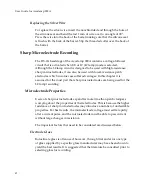
User
Guide
for
Axoclamp
900A
the
circuitry.
It
also
provides
the
means
for
injecting
current
into
the
microelectrode
and
for
neutralizing
the
input
capacitance.
Current
in
each
microelectrode
is
continuously
measured
during
both
voltage
clamp
and
current
clamp.
This
measurement
does
not
include
currents
from
sources
other
than
the
microelectrode
(
e
.g.,
hum,
iontophoresis,
the
other
microelectrode)
and
indicates
zero
if
the
microelectrode
blocks.
The
Meaning
of
H
A
precision
resistor
(R
0
)
inside
the
headstage
sets
the
headstage
current
gain
(H).
The
particular
value
of
H
used
affects
the
Bridge
range,
the
sensitivity
to
current
commands,
the
sensitivity
of
the
current
monitors
and
the
gain
in
SEVC
mode.
Since
the
effects
always
appear
in
multiples
of
ten,
they
are
easy
to
calculate.
For
your
convenience,
Table
1
summarizes
these
effects.
Note
that
voltage
commands
during
voltage
clamp
and
recorded
voltages
are
not
affected
by
the
headstage
current
gain
value.
H ×10
×1
×0.1
R
0
1 M
Ω
10
M
Ω
100
M
Ω
Max. Bridge Balance
8 M
Ω
80
M
Ω
800
M
Ω
Max. Step Command
±10,000 nA
±1000 nA
±100 nA
Max. DC Current
Command
±1000 nA
±100 nA
±10 nA
Ext. Command
100 nA/V
10 nA/V
1 nA/V
Max Total Current
1
12 µA
1.2 µA
0.12 µA
I Output
1 mV/nA
10 mV/nA
100 mV/nA
Max. Gain in dSEVC
3000 nA/mV
300 nA/mV
30 nA/mV
Max. Gain in TEVC
50000
50000
50000
Table
1.
How
H
affects
control
and
measurement
range.
1
Assumes
that
electrode
resistance
is
negligible.
74
















































